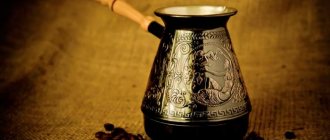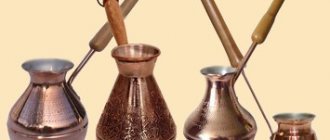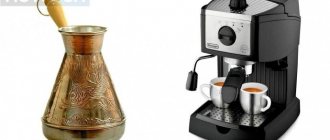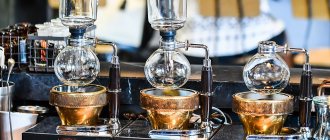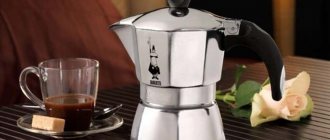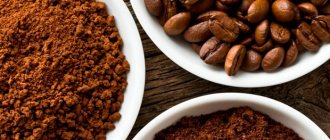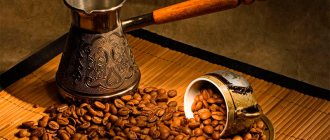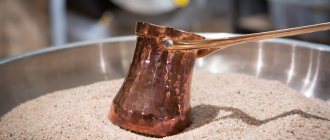There are many devices that make it possible to brew aromatic espresso. Even automated coffee machines have been invented that allow you to prepare a coffee drink with a minimum of effort. At the same time, classic recipes involve the use of cezve and turk. The difference between coffee brewed in such a container is immediately noticeable. It acquires a refined taste and a distinctly noticeable aroma.
A little history
The vessel with the unusual name ibrik is called the first utensil for brewing coffee. At its core, this is just a beautiful jug. Its long spout is good for pouring hot liquid, and the design itself holds up well to being carried over long distances in bags. Typically, ibriks were not made large - their volume did not exceed 300 ml. But nothing prevented them from being large in size, since they could be used to store water.
They were replaced by dalla . It became popular during the import of coffee to Arabia. In those years, it ceased to be considered a drink of common people and confidently entered the diet of rich people.
That is why the dalla, although it was also an ordinary jug, looked much richer, more picturesque, and more luxurious.
Its main differences were the hammered pattern and the material itself - metal instead of clay. In addition, dalla was used exclusively for coffee, and not for water. Gradually they began to make it in a cone shape, and thus the cezve we got, which we are all accustomed to today.
After some time, another interesting device was invented - a percolator . This is what the inventor (a French priest) named it from the word percolare - “to seep through, penetrate.” The whole structure consisted of two parts and worked quite simply. Ground coffee was poured into the upper bowl, in the walls of which holes were made, and boiling water was poured over it generously. The liquid seeped into the lower container already saturated, that is, in the form of a tasty, invigorating, aromatic drink.
Classification
The assortment of modern tableware includes many varieties of coffee pots. They are made from different materials, differ in thermal conductivity, features and duration of operation, and cost. In order for your purchase to meet all expectations, you need to understand the key advantages and disadvantages of common types.
By heating method
Depending on the characteristics of heating coffee, there are 4 main models of Turks.
| Types of Turks for making coffee | What is | Advantages | Flaws |
| Classical | A traditional trapezoidal product designed for brewing coffee on a gas stove or hot sand | Suitable for preparing coffee according to any recipe | The disadvantages directly depend on the material from which the Turk is made |
| Electric | Connects to the mains. Provides a larger volume than similar products and is equipped with various sensors and indicators | Requires minimal time to prepare a drink - from 30 to 60 seconds, takes up little space, easy to use | The appliance must be descaled regularly. The taste of the finished drink is inferior to coffee brewed in a classic Turk |
| For glass ceramics | A classic-shaped Turk made of ceramic, clay, glass or porcelain with a thick, flat bottom | The glass-ceramic stove heats up for a long time, which allows you to fully reveal the taste of coffee | A Turk that is not removed from the stove in a timely manner quickly becomes unusable. |
| For induction cooker | Such Turks are made of ferromagnetic alloys, mainly steel | A model purchased specifically for an induction panel can be used on other hobs | The bottom area of the Turk should cover at least 70% of the burner. An additional adapter is required for even heating |
A proper coffee pot must meet the basic requirements: wide bottom, narrow neck, material with high thermal conductivity. All other factors depend on the operating conditions of the product.
For induction cooker
For glass ceramics
Classical
Electric
By volume
The capacity of the dishes is an important criterion. To find out which Turk is better to buy, you need to decide on the number of people who will use it. The classic option is a 100 ml cezve. It will only be enough for one person, because when the liquid boils there should be room for the rising foam. Accordingly, 1–2 teaspoons of ground coffee are poured into 50–75 ml of water. For 2-3 family members, it is worth considering options for 350-500 ml. For more people, the 750 ml Turk will become indispensable.
The water level should be close to the neck of the product, so it is not recommended to brew one portion of coffee in a large Turk - this way the foam plug will not be dense or will not form at all.
By design
It is necessary to choose a coffee pot based on its shape, which affects the preparation process and the taste of the drink:
- Conical. With a wide bottom and tapering sides that hold most of the coffee grounds. The narrow neck ensures the formation of a plug, and the foam catcher prevents spillage. Usually made of copper, brass, aluminum.
- Cylindrical. Heats water unevenly. Due to prolonged exposure to high temperatures on the bottom layer, the usual taste of coffee changes. Turks of this shape are mainly made of steel.
- Barrel-shaped. The manufacturing material for such products is usually ceramics or clay - they maintain the temperature for a long time, providing a more pronounced taste of the drink. However, due to its high heat capacity, the foam may escape even if the ceramic coffee pot is removed from the stove in time.
The optimal wall thickness of a metal Turk is 1.5 mm. Only clay and ceramic products have greater value. Some manufacturers make only the bottom thick, which indicates the connection of the two parts. Such a design often indicates the fragility of the Turks, because due to regular temperature changes, the quality of the seam decreases.
Barrel-shaped
Conical
Cylindrical
Which Turk is better to brew coffee in?
Devices vary in shape, material, size. Amount of liquid held: 70 – 500 ml. The drink can be prepared for a group by choosing the largest container, but the coveted foam will not be enough for the whole family, so it is better to use several small containers.
For those who value the preservation of fatty oils, professionals recommend choosing tall containers. The water boils slowly, and it is difficult to miss the rise of the coffee cap. Prolonged foam growth occurs naturally due to the shape and height. They are divided into types:
- conical - heats the contents more evenly, and the narrow neck allows you to form a “plug” on the surface and, most importantly, prevent intense bubbling;
- cylindrical - heating occurs less evenly than in a conical pot, and mistakes made during cooking threaten damage to the finished product;
- barrel-shaped - the material for such models is often selected from clay, where the drink continues to languish even without heating.
It is difficult to clearly answer the question of what kind of Turk should be. Everyone’s preferences are different, but the rich abundance of containers for preparing everyone’s favorite coffee allows you to choose a model that will satisfy your personal requirements.
What is a cezve
Cezva is a Turkish word that means “hot coal”. This is the name of a special vessel for brewing coffee powder. It is a container with a wide bottom, a narrow neck and a long handle.
Traditionally made of copper and with an interior lining of food-grade tin or silver (on more expensive models). Copper forms soluble compounds that are harmful to our body, and the internal coating prevents these compounds from forming.
Before using a copper cezve, be sure to check the condition of the inner coating; if the copper is visible, the cezve needs to be changed.
Cezves are made from stamped and forged copper. Stamped cezves are thin-walled. This does not have the best effect on making coffee, but their prices are much lower. Heavy forged cezves are traditional. They have a thick, massive bottom and strong walls; on the outside, as a rule, they are decorated with applied embossing.
Copper cezves have been used to make coffee on sand (in Turkish) since ancient times. To do this, a metal baking sheet is filled with river sand and pebbles and placed on the fire. After 1.5 - 3 hours, the sand becomes hot and the coffee in the cezve is placed on it. The result is an aromatic drink that cannot be prepared in coffee machines. This brewing method is called classic.
Material of manufacture
Cezves are traditionally made of copper as the most fusible metal, because since ancient times they have been made in small workshops. Copper quickly oxidizes and becomes covered with a green coating, which is very harmful to the body, so the inside was covered with tin, which is safe for humans. In some regions of Turkey, cezves were made from baked clay.
Today they are made from various materials such as onyx, cupronickel, brass, silver and even gold. The same can be said about the Turks. If earlier they were made in the likeness of a cezve from copper, and the inner part was made of tin, today you can buy this item from any material.
How does a Turk differ from a cezve?
So, ladles designed for brewing coffee are called turks or cezves. In fact, the only difference is in the name. This is the same container, it’s just that its true “name” could not take root in Russia. It seemed very difficult to pronounce. In other countries the name “cezva” is also not always used. It is known in the world as serjep and fainjan.
True, among coffee lovers there are those who are convinced that there is still a difference between these two vessels.
The difference is that the neck of the cezve is significantly narrower and longer. In Turks, the shape of this part is funnel-shaped.
Cezva (Turkish)
The cezve (Fig.
Rice. 8. Cezve. In a real Turka, the diameter of the bottom is at least twice the diameter of the neck
This is how the cezve was born - a thick-walled ladle with a narrow neck and a comfortable straight handle. Since Turkey at that time was one of the most powerful states in the world, coffee, the method of preparing it and the name of the coffee pot - cezve - became known almost throughout Europe. But in the Arab countries of the Mediterranean, the coffee cezve is called “rakwa”.
Another name for the cezve, the Turk, has also stuck in Russia: the ladle came from Turkey. In Serbia, Bulgaria, the Czech Republic, Poland and most Eastern European countries (except Romania), this coffee pot is called a cezve.
In Western Europe, cezves are not particularly popular: the indigenous people prefer coffee makers. Therefore, for example, in Germany, not every seller will understand if a buyer asks him about a cezve. The Germans more often call it kaffeekännchen (“coffee jug”).
Correct form of Turks
In France, the term cezve turque (“Turkish cezve”) is used. In the Cypriot dialect of Greek, the vessel is called not only cezve, but also “briki” (μπρίκι) - from the Arabic “ibrik”. In all English-speaking countries, including the USA, as well as in Romania, the cezve is called “ibrik” and nothing else.
To avoid confusion, at international coffee-making competitions they always write and announce “cezva/ibrik” or “cezva/ibrik/turk”. Many well-known online stores, including Amazon, indicate this in the product descriptions. Therefore, some coffee lovers have the opinion that cezve and ibrik are synonymous. There was even a tendency to call all vessels for brewing coffee Turks.
What is Turka
Turk is a special vessel for preparing coffee powder with a narrowed, funnel-shaped neck, wide bottom and long handle. It is made of both copper and: ceramics, stainless steel, brass, clay and other materials.
The word “Turk” itself was invented in Russia. The thing is that the name “cezva” did not take root there, so they began to call it Turk, as a sign of the popular preparation of coffee in Turkish (on sand). By and large, turk and cezve are different names for the same utensils for brewing coffee.
Form
Thanks to the thick bottom, the drink is brought to a boil slowly and brews stronger. The base of the vessel is 2 times wider than the neck. This allows the liquid to warm up more evenly, and the aromatic substances evaporate more slowly: the rising foam serves as a kind of “stopper”. Water must be poured to the narrowest part of the neck.
There is an opinion that the Turka differs from the cezve in shape: its neck is slightly wider.
A long handle is needed to avoid getting burned. This is especially important when cooking in the traditional way - over coals. Most often the handle is made of wood. For convenient storage, the handle is equipped with a loop by which the Turk can be hung.
Which Turk to choose for coffee
Turks are made from different materials, and the brewing technology and taste of the drink depend on their quality. Apply:
The most popular varieties have their own advantages over others, and their properties have long been appreciated by coffee lovers. Among the wide variety, a reference group stood out.
- Copper Turk. It differs from other modifications in its high thermal conductivity, so the vessel heats up more evenly even on a regular stove, not to mention sand.
They are cast and can consist of only two fragments, and if someone wants to choose the right Turk, then only a solid device provides both durability and delicious taste. The copper vessel can be a thick or thin device. Thin-walled devices are usually purchased as souvenirs, the edges are often cut off, they are elegant, but the decorative designs are unclear. For everyday use, buy from dense metal:
- with special processing around the edges;
- thick bottom;
- with a noticeable difference in size between the throat and bottom
Models, as a rule, have a healthy coating made of stainless steel, silver, and tin. The consumer’s task is not to damage the inside of the vessel and to ensure that scratches and chips do not form. A container forgotten on the stove melts the tin coating, and the vessel becomes unusable. Careful handling helps avoid trouble. There are people who are convinced that regular rinsing with water creates a coffee residue over time, and this contributes to a juicier taste of the drink.
- Aluminum Turk. Its thermal conductivity is significantly lower in relation to copper vessels, but this does not interfere with uniform heating. Turks made of aluminum are unpretentious, safe, and the only drawback is their simplicity of appearance. They are cheap, durable and do not require special care. Often there are models with an irregular shape, due to which some of the aroma is lost.
- Steel Turk. It heats up unevenly due to low thermal conductivity. With a hot bottom, the body remains cold for some time. Their throat is usually wide, and the taste is less pronounced. The main advantage of steel models is their reliability, low cost, and ease of maintenance. Manufacturers often make such vessels of irregular shape, which deteriorates the quality of the drink.
- Ceramic group. The clay pot impresses with the extraordinary results of the coffee it produces. The porous material allows air to pass through, and thanks to this quality, it draws out all the most valuable things from the powder.
The peculiarity of clay vessels is their “age”: the older they are, the deeper the nuances of the finished product. For lovers of real taste, it is better to purchase clay Turks. Possessing powerful thermal conductivity, ceramic products heat up slowly and continue to simmer the contents after cooking. - Quartz group. They are transparent, the cooking process is always visible, this allows you not to miss the moment of boiling. Crystal models differ from copper or brass cookware in that they do not oxidize, conduct heat no worse than ceramic coffee makers, and this makes them a winner in the Turkish series.
Review of Turkish manufacturers
True coffee connoisseurs buy exclusive models from professionals in a single copy. These Turks have a unique design, often decorated with handmade sculptures and drawings. They are much more expensive in price than mass-produced ones. If you can’t buy a handmade Turk, check out the list of the most famous companies specializing in the production of coffee utensils:
- Becker (Germany);
- TimA (RF);
- Vitesse (China);
- Regent (co-production between Italy and China);
- Stanitsa (RF).
The listed manufacturers produce high-quality models using only reliable and proven materials. Products undergo strict quality control and meet international standards. By choosing one of these companies, you can be sure that the model will last a long time and will delight you with a freshly prepared aromatic drink. Each of the manufacturers offers a wide range of different coffeeware options, so consumers can choose any model they want.
TimA TU-550s
Turka by TimA is ideal for preparing a natural coffee drink. The body is made of M1M copper with a sheet thickness of 0.8 mm. The external walls are decorated with beautiful ornaments in oriental style. Lead solder is not used in the production of Turks. The walls and bottom are connected by cold rolling. Consequently, contact of the drink with lead, which is harmful to health, is excluded. A food can with a thickness of 9 to 12 microns was used as an internal coating. The outer surface is covered with heat-resistant paint to preserve the natural shade and shine of the material. A convenient spout allows you to pour the drink. The removable wooden handle is screwed on. The capacity of the pot is 0.5 l.
The drink is produced according to a classic recipe and retains significant strength, aroma and taste.
Advantages:
- ease of use;
- narrow handle with spout;
- classic cone-shaped configuration;
- nice design;
- manufacturing material – copper.
Cracking:
- the lower diameter is too small, the device is not suitable for all types of slabs;
- The thread sometimes unscrews spontaneously.
Mallony MAL-600
A 0.6-liter pot with a non-stick coating allows you to prepare an unusually tasty drink. The case is made of stainless steel. Eco-friendly inner lining is applied in 2 layers. The height of the device is 7.6 cm. For ease of use, the handle is made of heat-insulating material.
One of the advantages that all buyers note in the reviews is the optimal volume. Enough for 2 cups of coffee. The steel Turk had no downsides.
Stanitsa Gratsia (350 ml)
The Turk of domestic manufacturers is made of copper. The capacity of the Turks is 0.4 liters. It has a removable wooden handle and spout for easy pouring of your finished drink. The handle is rigidly fixed, so there are no problems in using the device. A food can is used as an inner liner, the layer thickness is 9-12 microns. The outer surface is painted with a heat-resistant effect.
Key Features:
- Diameter: maximum – 95 mm, top edge – 50 mm, bottom – 65 mm;
- product height 110 mm;
- handle length 185 mm.
Main advantages:
- graceful appearance. The name is one hundred percent justified;
- fast preparation and excellent quality of the finished product;
- smooth outer surface for easy maintenance;
- optimal volume;
- classic jug shape;
- strength and safety of materials.
Disadvantages: not installed.
MAYER & BOCH (copper, 300 ml)
One of the best options for preparing a natural coffee drink. The body of the cookware is made of M1M copper. Black nickel was chosen as the outer coating. The inner liner is safe for a health food can. The handle is made of heat-insulating material. Product weight 167 g, capacity 300 ml. The height of Turks is 105 mm.
Advantages:
- reasonable price;
- treatment;
- environmental friendliness;
- good quality coffee.
There is no consensus regarding the volume of the product. Some users consider it optimal, others find it too small. No critical issues found.
Taller Jackie TR-1333 (500 ml)
The material of the Turks is high-quality stainless steel 18/10 with an anti-corrosion effect. The material is durable, chemically neutral for acidic and alkaline environments. The shape of the spout prevents the formation of subsidence that pollutes the surface. Handle material: bakelite with good thermal insulation properties. The capacity of the Turk is 0.5 liters, height 97 mm.
Advantages:
- quality products;
- convenience.
Cons: none.
GiPFEL Maree 5574 220 ml
The stainless steel pot is equipped with a spout that allows you to pour the drink without losing a drop. The design of the product is classic, the Turk will easily fit into any interior. The stainless steel from which the cookware is made is of good quality and is resistant to wear and oxidation. The handle is made of bakelite – a non-slip, heat-resistant material. The product can be washed in the dishwasher and used on induction cookers. All materials for the table are environmentally friendly.
Model features:
- capacity – 220 ml;
- weight – 300 g;
- height – 80 mm;
- silver color.
Positive reviews:
- volume. This is a selfish dish that barely makes enough for 1 glass;
- low price.
Minus: the induction cooker does not always “see” the device due to the small contact area. The problem is solved with the help of an adapter.
Ceraflame Ibriks (500 ml)
The original ceramic product with a volume of 0.5 liters attracts not only its beautiful design (although this cannot be taken away from Ceraflame Ibriks). This is a wonderful gift for a true coffee connoisseur.
Product Features:
- environmental cleaning. Coffee prepared in ceramic containers is very aromatic and has a unique taste;
- good level of heat capacity. The material cools slowly. The cooking process then continues after the pan is removed from the heat;
- scratch resistance. The ceramics were fired at a temperature of 1300 degrees, which gives the material high strength. The coating remains intact even after cleaning with abrasive compounds and hard brushes;
- resistance to extreme temperatures (from -30 to +900 degrees). The product can be placed on an open fire. Putting a hot Turk in ice water won't hurt.
There is only one drawback: the fragility of ceramics. It is quite durable, but can break if dropped.
BergHOFF Zeno 1107625
Turk 0.55g made of high quality stainless steel. The convenient volume (0.55 l) allows you to use the dishes not only for a coffee drink, but also for heating water or milk. Heat-insulating polypropylene handle. Product height 95 mm, weight 480 g. The interior finish is matte, the exterior is mirrored. Can be washed in the dishwasher.
Advantages:
- good abilities;
- ease of use;
- reliable heat-insulating handle;
- ease of maintenance.
Cons: limited range. The Turk cannot be used on an induction hob.
Vetta 847-030 400 ml
The 0.4 liter pot is made of chemically neutral stainless steel. Bakelite handle, heat insulating.
Advantages:
- impeccable workmanship;
- ease of use and maintenance.
Cracking:
- small volume;
- cannot be used on an induction hob.
Elros enamel (400 ml)
Turk made of enameled steel with a comfortable handle. It will fit perfectly into the interior of the kitchen and will be a wonderful gift for a relative or colleague. The product can be washed in the dishwasher. Tabletop diameter 90 mm, height 100 mm. Handle length 125 mm.
What factors influence the taste of Turkish coffee?
You can get a wonderful drink thanks to a successful ensemble of shape and material, but in order to prepare a real masterpiece in the oriental style, such indicators as:
- grain type;
- cooking method;
- amount of powder (the more it is, the richer the finished product);
- seasonings are essential additives that affect taste;
- brewing time - radically changes the density of the extracted substances.
The most difficult task is preserving aromatic oils. They form the coffee film, influence the taste and prepare the receptors for the perception of the magical fragrance. If the foam cannot be preserved as a solid film, this leads to undesirable changes in aroma. The drink turns out bitter. Coffee like
What other devices are there for brewing coffee?
There is more than one vessel for brewing coffee. Among the ancient dishes, the following are distinguished:
The history of coffee began about a thousand years ago, and they began to brew it in hot water 8-9 centuries ago. It is clear that this required dishes. The first were unassuming kettles and saucepans, but soon the wandering Bedouins adapted special jugs - ibriks - for preparing the drink. Experts and ethnographers claim that their origin is so ancient that it evokes awe and reverence.
Ibrik
The word is of Arabic origin (according to some sources - Persian). Composed of two words - “water” and “pour”.
It is believed that it was the ibrik that became the first coffee utensils. In essence, this is a simple Bedouin jug that could be carried for travel and hold a minimal amount of liquid. Archaeologists have also found stationary ibriks that could mix up to 100 liters of liquid. Of course, coffee was not brewed in such containers, but used for water or wine.
A special feature of the ibrik was its long spout, through which it was convenient to pour hot liquid.
Another feature was the round sides, offset towards the bottom. They provided capacity and stability.
Despite its reputation, after a couple of centuries the ibrik had to make way for a new container for coffee called the dalla.
Dalla
In the vastness of Syria, a vessel called dalla was popular. This is, in fact, a modified version of irbik. The spout of the ladle is short, and the handle is straight and elongated. The bottom of the container is thick and wide, and the neck is narrow.
The use of dalla became popular when coffee drinks began to be consumed not only by nomads, but also by wealthy people. The dishes looked luxurious. It was decorated with chasing.
Elegant containers were found in the homes of nobles and merchants. Ordinary people were content with simpler versions of these vessels.
The difference between dalla and irbik was the purpose of the jug. The first option was used only for making coffee, while the second could be used to pour various drinks. Archaeologists even managed to find an irbik with a volume of one hundred liters. Naturally, it could not be used to make coffee. Wine or water was poured into such a jug.
What are the main differences between cezve and Turkish
Ibrik is the first utensil for making coffee, the name comes from the Persian phrase “water” and “to pour”. The main feature is the long nose, which makes it convenient to pour the drink into the cup.
Ibrik, the first utensil for making coffee, comes from the Persian phrase “water” and “to pour.”
Over time, the ibrik was replaced by a new device - the dalla. This happened at a time when the drink became more popular and began to be used in high circles of Arabian society. In appearance, it was a jug with an elongated neck with beautiful embossing and a small spout. The main difference from its predecessor is the metal structure, while the previous copy was made of clay.
Dalla's appearance was a jug with an elongated neck, beautiful embossing and a small spout.
Before you find out how a Turk differs from a cezve, you need to know the history of their creation and popularization. When coffee gained immense popularity in Turkey, a traditional and well-known product was invented - cezve.
This kitchen utensil owes its appearance to the need to brew small portions of coffee, since large volumes of coffee drink were brewed in dall. Turka is the same product, but this is the name that took root in Russian society many centuries ago.
This kitchen utensil owes its appearance to the need to brew small portions of coffee, since large volumes of coffee drink were brewed in dall.
In order not to get confused in the purchasing process, cezve or turk, remember: these are two names for one item.
Jebena
Jebena is the closest relative of the ibrik. The Ethiopian jebena (Fig. 3) is a squat ceramic jug with convex sides, a narrow neck and a spout slightly shorter than that of the ibrik. A horsehair filter is placed at the base of the spout to retain the grounds.
The Eritrean jebena (Fig. 4) differs from the Ethiopian in the absence of a spout. It is replaced by a groove on the neck. Coffee brewed in a jebene is poured into tiny ceramic cups called finjans.
Ethiopian jebena
Eritrean coffee ceremony. Woman pouring coffee from a jebena into a finjan
Local potters sell black and red (or brown) jebens. Black jugs are fired and ready to use. But coffee connoisseurs prefer to buy red, unroasted jabens. Spent coffee is thrown into such a vessel, filled with water and put on fire. After boiling for 1–2 hours, the inside of the jebena becomes saturated with the aroma of coffee and turns black.
Ceramic jug
In France in the eighteenth century, an extraordinary device was invented in which coffee was brewed. It was a jug made of ceramics. A plate resistant to high temperatures was placed on its bottom. Coffee drink lovers used this utensil for a very long period.
Percolator
After some time, the French archbishop invented the percolator. The name of this device comes from the word percōlāre, which translates as “seepage.” The mechanism worked on a simple principle. A vessel with small holes made in the walls was placed in the upper part of the structure and coffee was poured into it. After this, boiling water was poured into the dishes. Thus, in the lower part of the structure there was an invigorating drink.
Turka (aka cezve) is a unique jug that has continued to be used for a huge number of years to obtain an aromatic invigorating drink. Recipes change, different coffee varieties are used, but this tableware remains in demand. Many true coffee lovers do not accept other devices and are convinced that truly aromatic and tasty coffee can only be prepared in such vessels.
Selection tips for different types of slabs
Any metal Turk is best suited for electric stoves. The same can be said about gas stoves. But here it is necessary to take into account that when exposed to fire, the decorative coating burns. To prevent this from happening, place the Turk on an unperforated fire partition.
Turkish clay, ceramic and porcelain can also be used with a gas diffuser.
Ceramic hobs have no restrictions for Turkish coffee, as long as the bottom is smooth.
On an induction cooker, you can only use a steel turret or one with a ferromagnetic coating on the bottom. Keep this in mind when purchasing a Turk.
Interesting facts about the Cezve Turks
There are many funny and instructive stories associated with this dish.
- In the countries of the Middle East, the wealth of the owner could be determined by the cezve. In rich houses, coffee was brewed in silver vessels, for everyone else there was copper and its alloys, and the poor used a clay pot.
- It is believed that Turku was invented in Turkey, but this is not so. She came to this country along with coffee. The Turks simply spread the dishes around the world, again, along with coffee and their own recipes for its preparation.
- After the inventor of the cezve presented it at the court of the customer-sovereign, he, as a reward, gave the right to monopoly trade in the new product to its creator. This permission brought a fortune to the savvy vizier, who came up with the conical cezve.
- The Turks make the neck narrow so that the rising foam acts as a cork, preserving the aroma and taste of the drink as much as possible, preventing them from evaporating.
Modern containers for coffee with a wide neck are just scoops, but not Turkish cezves.
- The classic parameters of a cezve are considered to be the ratio of the diameter of the bottom and neck as 2 to 1. The bottom can be even wider, this is only for the better.
- Craftsmen have attempted to crossbreed dallu, ibrik and cezve. The resulting vessel had round, low sides, like an ibrik, a top with a narrow neck, like a cezve, and a lid, like a dalla. We were unable to find data on the quality of coffee from this dish, but the very attempt to combine all the traditions in one device deserves respect.
There are no differences between a cezve and a Turk , so call your favorite coffee device whatever you want. Treat yourself to a fresh drink brewed according to classical traditions, and may your every morning be exceptionally invigorating!
